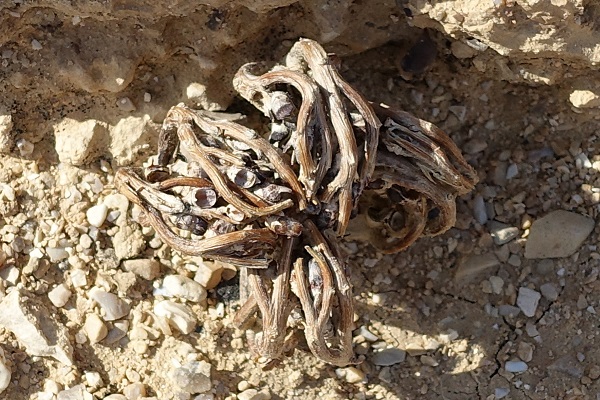Hebrew: שושנת-יריחו אמיתית, Arabic: Keff Maryam (كف مريم), shajarat Maryam (شجرة مريم)
| Scientific name: | Anastatica hierochuntica L. | |
| Common name: | Rose of Jericho, Resurrection plant, Virgin's Hand, Mary's flower | |
| Hebrew name: | שושנת-יריחו אמיתית | |
| Arabic name: | Keff Maryam (كف مريم), shajarat Maryam (شجرة مريم), Aisha's palm (كف عائشة ) | |
| Family: | Cruciferae / Brassicaceae, מצליבים |

|
| Life form: | Annual, between 5 and 10cm with a rosette of branches and leaves from the top of its heavy tap-root, a tumble weed | |
| Spinescence: | Absent | |
| Succulence: | Non-succulent | |
| Stems: | Everywhere hoary, with dense stellated hairs | |
| Leaves: | Alternate, entire, lanceolate to obovate, covered with dense hairs, roughly toothed, 3cm. long and 2cm. wide, falling rapidly | |
| Inflorescence: | Racemes lateral, erect, rigid, almost spiny, bearing seven or eight nearly sessile inconspicuous flowers | |
| Flowers: | Hermaphrodite only, calyx of four stellato-pubescent sepals; white petals orbicular, clawed, longer than the sepals; stamens six, four long, two short;anthers oblong, yellow | |
| Fruits / pods: | Hairy ovoid silicula with two wings | |
| Flowering Period: | December, January, February, March, April | |
| Habitat: | Desert | |
| Distribution: | Shrub-steppes, Deserts, Semi-steppe shrublands | |
| Chorotype: | Saharo-Arabian | |
| Summer shedding: | Ephemeral |

Derivation of the botanical name: Anastatica from Greek Anastasis, resurrection, in allusion to the fact that no mmatter how dry it may have become, the plant recovers its shape on being placed in water. hierochuntica from the classical name of the town of Jericho. Mary's flower because of a legend which affirms tht all of the plants of this species expanded, became green, and blossomed again at the birth of Jesus, and still do so in commemoration of this event. The Rose of Jericho, though not a rose, whose flowers are small and white and have little beauty. The Hebrew name: שושנת-יריחו, shoshannat-Jericho,שושנה, shoshanna (name Susannah), lily, rose, a translation of the popular name of the plant, Rose of Jericho, that was widely used in Europe. The Hebrew word: אמיתית, amitit "true" addition comes to indicate the Christian belief that the plant is a "living plant" - a plant whose behavior is reminiscent of the return to the life of Jesus. This belief comes because the (dead) plant opens in the rain and so the seeds can be distributed.
The characteristical root horizon of Anastatica in a natural environment is controlled by the soil moisture content, the nitrogen supply and the mechanical impedance of the soil.


|